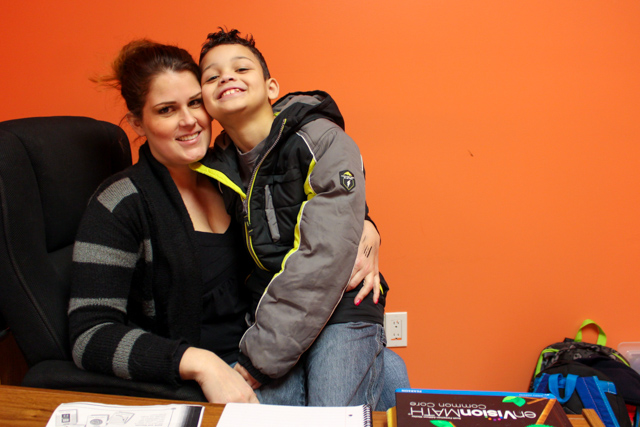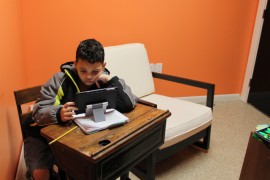Eight-year-old Gabriel Dispenziere spends most of his day in a tiny, bright orange room, which is hardly big enough for the small desk where he does his schoolwork and the slightly larger desk for the tutor who visits for an hour each afternoon. He is currently flipping through games on his iPad, which has a colorful Pokemon background and crack in the corner of the screen.
“Why can’t you go to school, Gabriel?”
He shrugs. “Because of my allergies.”
“And what are you allergic to?”
“Everything.”
Gabriel, who moved to Riverhead from California with his mother last May, has a rare allergic condition that prevents him from eating any food. His allergy is so severe that he can’t even be near food or people who might have food on their hands or breath.
Although he is bright and talkative — he likes to brag with a toothy grin that he skipped first grade— Gabriel’s condition has forced him to spend much of his childhood in near-isolation. His excursions into the outside world are limited to places that are absolutely food-free, which, as it turns out, are not many.
“You don’t realize how important food is to our society until you have to go without it,” said Raquel Dispenziere, Gabriel’s mother. “Our country uses food to celebrate every holiday, every birthday. Even rewards in classrooms — a pizza lunch, an ice cream party — it’s everywhere.”
For most of his childhood, Gabriel’s allergy has made it impossible for him to attend school, where he would be exposed to airborne food allergens from students’ snacks and lunches.
But this year, with the help of Riverhead Central School District’s special education department, Gabriel has been able to experience a classroom for the first time in his life.
Miles away from where Gabriel sits with his iPad in his little orange safe-haven, another iPad mounted to a rolling stand provides a window into Robert Shilling’s fourth grade classroom at Aquebogue Elementary School. Using FaceTime, a video calling application similar to Skype, Gabriel’s face pops up on Shilling’s iPad every morning, where he is wheeled around the room to see the classroom’s Smartboard and to participate in book discussions with his reading group — Mikayla, Kyle and Shane.
“All these little things, like raising his hand to answer a question for the first time, making friends with classmates – he’s almost nine years old, and he’s never gotten to do them before,” Dispenziere said. “It’s crazy.”
‘No food at all’
Every night, after Gabriel changes into his pajamas, his mother hooks him up to a feeding tube through his abdomen. While he sleeps, a machine beside his bed pumps elemental formula into his stomach. Elemental formula, Dispenziere explained, is a special amino acid-based mixture containing zero food proteins, so it doesn’t cause Gabriel an allergic reaction.
“It smells terrible,” she said.
But it beats the alternative.
For the first few years of Gabriel’s life, his body was constantly at war with anything his mother tried to feed him. His condition was not diagnosed until he was two and a half years old, so he spent his infancy in a state of constant illness.
“He was in and out of the hospital his whole first year, because at that point, we had no idea what the problem was,” Dispenziere said. “He had pneumonia 10 times before his first birthday.”
Gabriel was hospitalized for the first time at just six weeks old. He was vomiting several times a day and having tremendous difficulty breathing. “That’s when they started thinking there might be some food involved,” Dispenziere said. She was still breastfeeding him at the time, so doctors instructed her to remove from her diet the most common food allergens — milk, eggs, nuts.
“He got a little bit better, but he was still so sick,” she said.
As time went on, they gradually removed more and more foods from his diet. “We continued to trial and see which foods were making him sick, and which he could tolerate,” she said. “Unfortunately, he’s lost them all. There’s no foods he can have.”
Gabriel was diagnosed at age two-and-a-half with eosinophilic esophagitis, commonly abbreviated as EoE. It is a rare condition that causes inflammation in the esophagus from allergic reactions to food. Some people with EoE are only allergic to a handful of foods.
Gabriel is allergic to all of them.

EoE has severely limited the places Gabriel can go. He has never set foot in a school, and has had to be tutored at home every year. He can’t go anywhere there might be food. One of the only safe public spaces for him is the beach, “because we can be isolated there,” his mother explained. In our interview, he bemoaned his inability to visit a movie theater and watch the newly released SpongeBob Movie. “It’s been out for so long,” he said. “I wish I could just see it already.”
His condition has forced his mother to get creative with holidays. “We try to make new traditions that aren’t about food,” she said. On Easter, they go to the beach and fly a kite instead of hunting for candy. Gabriel was able to celebrate Halloween for the first time last fall because his mother delivered small toys to family members beforehand. Gabriel visited them later in his first trick-or-treating costume: Captain America.
Oddly enough, the only thing Gabriel isn’t allergic to is sugar. Sugar contains no food proteins, and therefore doesn’t cause him any allergic reaction, his mother explained. She often treats him to Dum Dums lollipops. For his last birthday party, she rented a cotton candy machine because cotton candy is made purely from sugar. “It was cotton candy and snow cones all day long,” she said, and Gabriel giggled at his desk.
Every few months, Gabriel goes to a doctor to do another food allergy clinical trial. “Sometimes kids grow out of their allergies,” Dispenziere said. “We do trials to see if maybe there’s a food he can eat without having a problem, but so far, nothing’s been successful.
“He’s been with no food for quite a while. No food at all.”
Mr. Shilling’s classroom
When Dispenziere and her son were still living in California, she learned about students in other states who, like Gabriel, were unable to go to school, but were using technology to access the classroom.
“I thought, ‘What a great thing that would be for Gabriel,’” she said.
So she started asking her school district about implementing something similar for her son. These conversations went on for several years, she said, but to no avail.
“They kept saying it would happen, but it never did,” she said. “We’re just really lucky that Riverhead got this to happen so fast.”
Dispenziere moved back to her hometown of Riverhead last May. She immediately got in touch with the special education department at Riverhead Central School District, and says the director, Elizabeth Chappell, worked quickly over the next three months to make sure everything would be ready for Gabriel that fall.
So last September, using FaceTime, Gabriel attended his first class in Mr. Shilling’s fourth grade classroom.

Dispenziere described Shilling as the best thing that could have happened for her son. “He goes so far out of his way to include Gabriel,” she said. “We’ve been so lucky that he was put in Mr. Shilling’s class. He’s very interested in technology, and he is always finding new ways to include him in what they’re doing.”
“He takes pictures of the worksheets we’re doing and sends them to me,” Gabriel added.
When the elementary school students are bussed to the high school for an assembly, for example, Shilling makes sure to bring the iPad with him so that Gabriel can watch. Shilling has even brought the iPad on the bus on the way to the assembly.
“It seems so silly,” she said, “but for Gabriel, who has never been on a bus, he just thought it was the coolest thing. He was telling everybody, ‘I got to go on a schoolbus today!’”
Shilling has even put a shirt on the iPad’s rolling stand.
“[Gabriel] always seems happy to beam into our room,” Shilling said. “The other students love him. He is kind of famous around here.”
 Gabriel is the first student in Riverhead to be accommodated with FaceTime in the classroom, schools superintendent Nancy Carney said. But the school district doesn’t plan to stop with just the iPad. “We are looking into some new and innovative robotic technologies that will enable Gabriel to participate in activities on a deeper level,” she said. “We are looking forward to working with him for many years and accommodating his needs so that he can reach his full potential, academically and socially.”
Gabriel is the first student in Riverhead to be accommodated with FaceTime in the classroom, schools superintendent Nancy Carney said. But the school district doesn’t plan to stop with just the iPad. “We are looking into some new and innovative robotic technologies that will enable Gabriel to participate in activities on a deeper level,” she said. “We are looking forward to working with him for many years and accommodating his needs so that he can reach his full potential, academically and socially.”
For now, Gabriel and his mom are just grateful he can be transported to his classroom for a few hours every morning through the iPad screen. He signs off when students go attend specialty classes like art, music, physical education or (obviously) lunch. A tutor spends an hour every afternoon with him for work that needs to be done in person, such as tests or quizzes.
His favorite thing about finally being part of a class?
“Now I get to make friends,” Gabriel said, grinning.
‘Holding out hope’
Gabriel is a voracious reader. He went through two chapter books a week over the summer, his mother said. When he’s not reading or doing schoolwork, he likes to play video games, especially the popular computer game Minecraft.
“He’s an incredibly fast learner,” Dispenziere said. “It’s nice that he gets to go at his own pace when he’s doing work on his own. It gets a little lonely, but…”
“I have my Pokemon,” Gabriel interjected cheerfully.
One of the main reasons Dispenziere moved back to her hometown was to be closer to a hospital in Philadelphia, where there is a team of doctors who specialize in EoE. “That’s very rare to find with this disease,” she said. She is in the process of arranging a weeklong series of tests and treatments there.
In the meantime, they’ll continue doing supervised food trials to see if, perhaps, Gabriel has grown out of any of his allergies.
Last January, he tried a drop of pear juice. After another drop, however, he began to throw up.
“We’re just going to keep trying,” she said. “We’re still holding out hope. If there’s just one food that he can eat, any food at all, that will be better than nothing.”
The survival of local journalism depends on your support.
We are a small family-owned operation. You rely on us to stay informed, and we depend on you to make our work possible. Just a few dollars can help us continue to bring this important service to our community.
Support RiverheadLOCAL today.
































